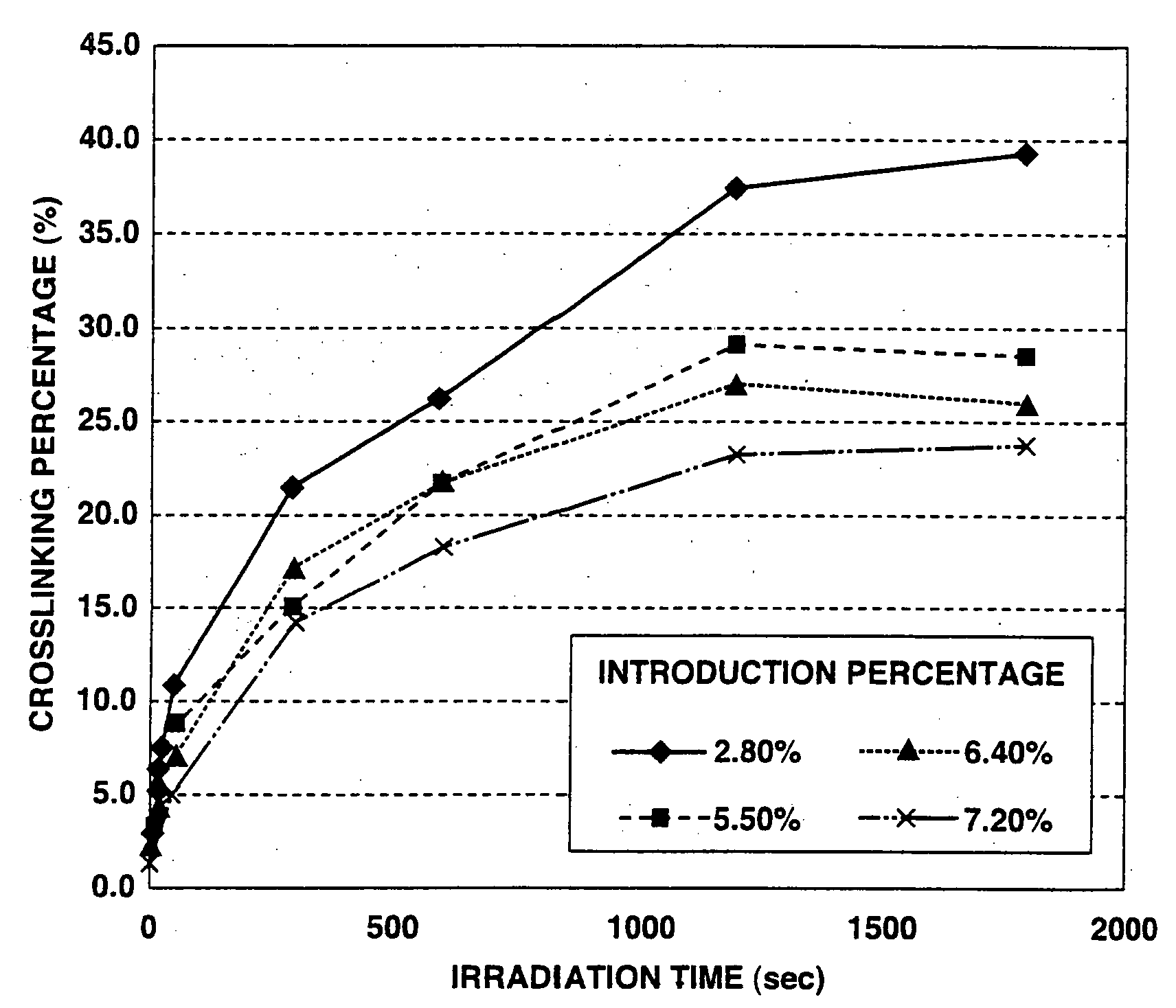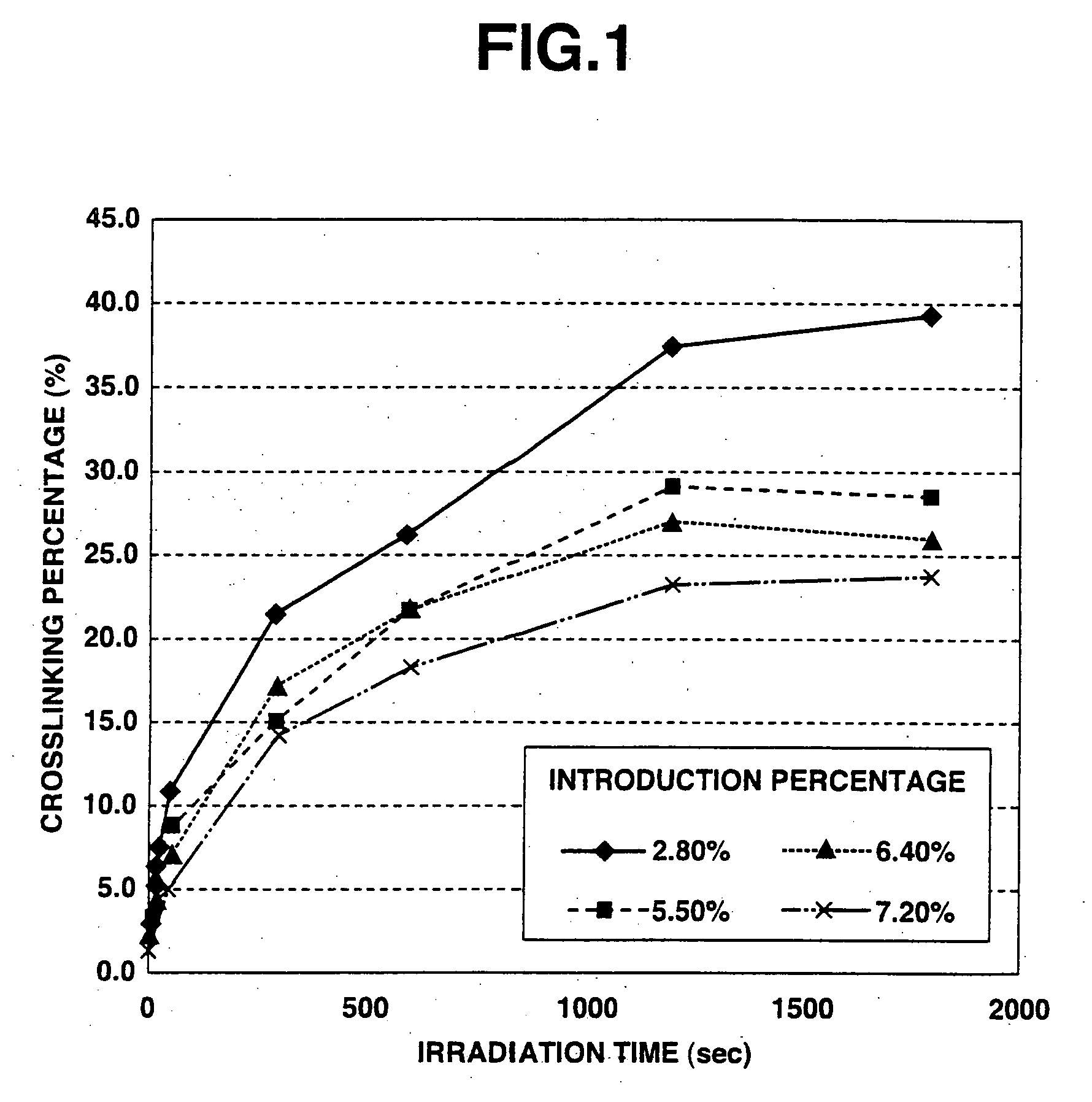Crosslinked polysaccharide sponge
a polysaccharide sponge and crosslinked technology, applied in the field of polysaccharide sponges, can solve the problems of difficult washing of porous materials such as sponges, easy decomposition in vivo,
- Summary
- Abstract
- Description
- Claims
- Application Information
AI Technical Summary
Benefits of technology
Problems solved by technology
Method used
Image
Examples
example 1
[0044] 1 g of photoreactive hyaluronic acid obtained by introducing aminopropyl cinnamate into 3% of whole carboxyl groups of hyaluronic acid (produced by Seikagaku Kogyo Corporation; weight-average molecular weight: 900,000) (introduction percentage: 3%) was dissolved in 25 ml of injection water to prepare a 4 wt. % photoreactive hyaluronic acid solution. The thus obtained aqueous solution was interposed between two hard (Pyrex) glass plates (produced by Asahi Technoglass Co., Ltd.) so as to form a layer of the solution with a thickness of 1 mm, and then rapidly frozen under an atmosphere of −80° C. While keeping the frozen state, the frozen solution was irradiated with light for 5 minutes using a high-pressure mercury lamp (400 W lamp manufactured by Shigemi Standard Co., Ltd.). After the irradiation, the obtained material was thawed at room temperature to obtain a white photo-crosslinked hyaluronic acid sponge.
[0045] As a result of visually observing the thus obtained photo-cros...
example 2
[0047] The frozen photoreactive hyaluronic acid solution produced by the same method as defined in Example 1 was irradiated with light for 7 minutes to obtain a photo-crosslinked hyaluronic acid sponge. The thus obtained photo-crosslinked hyaluronic acid sponge was a porous material and exhibited excellent water absorbing and discharging properties similarly to the sponge obtained in Example 1.
[0048] The section of the thus obtained photo-crosslinked hyaluronic acid sponge was observed by an electron microscope (scanning electron microscope “JSM-5200”). As a result, it was confirmed that the sponge had 92 pores per a photographed area (160×246 μm=39,360 μm2), and the 56 pores thereof (61%) had a pore diameter of 10 to 50 μm (FIG. 3).
example 3
[0049] 1 g of photoreactive hyaluronic acid obtained by introducing aminopropyl cinnamate into 3% of whole carboxyl groups of hyaluronic acid (produced by Seikagaku Kogyo Corporation; weight-average molecular weight: 900,000) (introduction percentage: 3%) was dissolved in 25 ml of injection water to prepare a 4 wt. % photoreactive hyaluronic acid solution. The thus obtained aqueous solution was interposed between two hard (Pyrex) glass plates (produced by Asahi Technoglass Co., Ltd.) so as to form a layer of the solution with a thickness of 1 mm. Then, the solution was rapidly frozen under an atmosphere of −80° C., and freeze-dried in vacuo at 20° C. under a pressure of 10 mmHg for 24 hours, thereby obtaining a photoreactive hyaluronic acid sponge (freeze-dried product). The thus obtained freeze-dried product was irradiated with light at ordinary temperature for 5 minutes using a high-pressure mercury lamp (400 W lamp manufactured by Shigemi Standard Co., Ltd.) to obtain a photo-cro...
PUM
| Property | Measurement | Unit |
|---|---|---|
| pore diameter | aaaaa | aaaaa |
| water content | aaaaa | aaaaa |
| water content | aaaaa | aaaaa |
Abstract
Description
Claims
Application Information
 Login to View More
Login to View More - R&D
- Intellectual Property
- Life Sciences
- Materials
- Tech Scout
- Unparalleled Data Quality
- Higher Quality Content
- 60% Fewer Hallucinations
Browse by: Latest US Patents, China's latest patents, Technical Efficacy Thesaurus, Application Domain, Technology Topic, Popular Technical Reports.
© 2025 PatSnap. All rights reserved.Legal|Privacy policy|Modern Slavery Act Transparency Statement|Sitemap|About US| Contact US: help@patsnap.com



